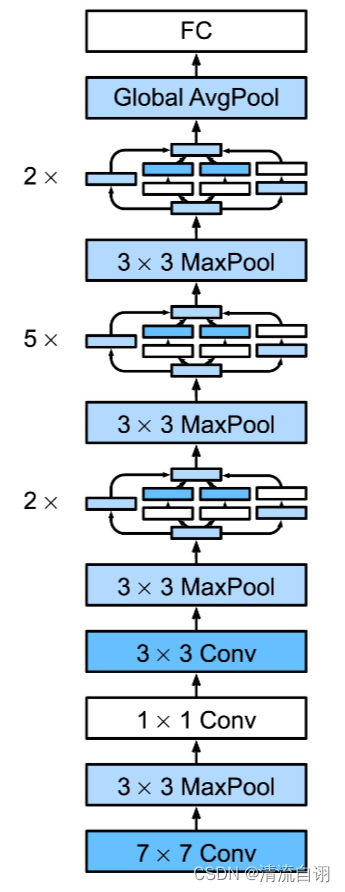突然翻到几年前刚开始学深度学习的代码,扒出来记录一下,再配点百度搜到的图,方便自己回过头看,以后有空就看些模型并记录
LeNet

class LeNet(nn.Module):
def __init__(self):
super(LeNet, self).__init__()
self.conv1 = nn.Conv2d(3, 6, 5)
self.pool = nn.MaxPool2d(2, 2)
self.conv2 = nn.Conv2d(6, 16, 5)
self.fc1 = nn.Linear(16 * 5 * 5, 120)
self.fc2 = nn.Linear(120, 84)
self.fc3 = nn.Linear(84, 10)
self.sigmoid = nn.Sigmoid()
def forward(self, x):
x = self.pool(self.conv1(x))
x = self.pool(self.conv2(x))
x = x.view(-1, 16 * 5 * 5)
x = self.sigmoid(self.fc1(x))
x = self.sigmoid(self.fc2(x))
x = self.fc3(x)
return x
net = LeNet()
VggNet

def vgg_block(num_convs, in_channels, out_channels):
net = [nn.Conv2d(in_channels, out_channels, kernel_size=3, padding=1),nn.ReLU(True)]
for i in range(num_convs - 1):
net.append(nn.Conv2d(out_channels, out_channels, kernel_size=3,padding=1))
net.append(nn.ReLU(True))
net.append(nn.MaxPool2d(2, 2))
return nn.Sequential(*net)
def vgg_stack(num_convs, channels):
net = []
for n, c in zip(num_convs, channels):
in_c = c[0]
out_c = c[1]
net.append(vgg_block(n, in_c, out_c))
return nn.Sequential(*net)
net = vgg_stack((1, 1, 2, 2, 2),((3, 64),(64, 128),(128, 256),(256, 512),(512, 512)))
print(net)
'''
Sequential(
(0): Sequential(
(0): Conv2d(3, 64, kernel_size=(3, 3), stride=(1, 1), padding=(1, 1))
(1): ReLU(inplace)
(2): MaxPool2d(kernel_size=2, stride=2, padding=0, dilation=1, ceil_mode=False)
)
(1): Sequential(
(0): Conv2d(64, 128, kernel_size=(3, 3), stride=(1, 1), padding=(1, 1))
(1): ReLU(inplace)
(2): MaxPool2d(kernel_size=2, stride=2, padding=0, dilation=1, ceil_mode=False)
)
(2): Sequential(
(0): Conv2d(128, 256, kernel_size=(3, 3), stride=(1, 1), padding=(1, 1))
(1): ReLU(inplace)
(2): Conv2d(256, 256, kernel_size=(3, 3), stride=(1, 1), padding=(1, 1))
(3): ReLU(inplace)
(4): MaxPool2d(kernel_size=2, stride=2, padding=0, dilation=1, ceil_mode=False)
)
(3): Sequential(
(0): Conv2d(256, 512, kernel_size=(3, 3), stride=(1, 1), padding=(1, 1))
(1): ReLU(inplace)
(2): Conv2d(512, 512, kernel_size=(3, 3), stride=(1, 1), padding=(1, 1))
(3): ReLU(inplace)
(4): MaxPool2d(kernel_size=2, stride=2, padding=0, dilation=1, ceil_mode=False)
)
(4): Sequential(
(0): Conv2d(512, 512, kernel_size=(3, 3), stride=(1, 1), padding=(1, 1))
(1): ReLU(inplace)
(2): Conv2d(512, 512, kernel_size=(3, 3), stride=(1, 1), padding=(1, 1))
(3): ReLU(inplace)
(4): MaxPool2d(kernel_size=2, stride=2, padding=0, dilation=1, ceil_mode=False)
)
)
'''
AlexNet

class AlexNet(nn.Module):
def __init__(self):
super(AlexNet,self).__init__()
self.conv1 = torch.nn.Sequential(
torch.nn.Conv2d(in_channels=3,out_channels=96,kernel_size=11,stride=4,padding=0),
torch.nn.ReLU(),
torch.nn.MaxPool2d(kernel_size=3, stride=2)
)
self.conv2 = torch.nn.Sequential(
torch.nn.Conv2d(96, 256, 5, 1, 2),
torch.nn.ReLU(),
torch.nn.MaxPool2d(3, 2)
)
self.conv3 = torch.nn.Sequential(
torch.nn.Conv2d(256, 384, 3, 1, 1),
torch.nn.ReLU(),
)
self.conv4 = torch.nn.Sequential(
torch.nn.Conv2d(384, 384, 3, 1, 1),
torch.nn.ReLU(),
)
self.conv5 = torch.nn.Sequential(
torch.nn.Conv2d(384, 256, 3, 1, 1),
torch.nn.ReLU(),
torch.nn.MaxPool2d(3, 2)
)
self.classifier = torch.nn.Sequential(
torch.nn.Linear(9216, 4096),
torch.nn.ReLU(),
torch.nn.Dropout(0.5),
torch.nn.Linear(4096, 4096),
torch.nn.ReLU(),
torch.nn.Dropout(0.5),
torch.nn.Linear(4096, 50)
)
def forward(self, x):
conv1_out = self.conv1(x)
conv2_out = self.conv2(conv1_out)
conv3_out = self.conv3(conv2_out)
conv4_out = self.conv4(conv3_out)
conv5_out = self.conv5(conv4_out)
res = conv5_out.view(conv5_out.size(0), -1)
out = self.classifier(res)
return out
net = AlexNet()
print(net)
'''
AlexNet是LeNet的升级版,大胆地采用了更深的网络结构、Relu、dropout、数据增强等。同时图片变大了,
感受野和步长也随之变大。
AlexNet(
(conv1): Sequential(
(0): Conv2d(3, 96, kernel_size=(11, 11), stride=(4, 4))
(1): ReLU()
(2): MaxPool2d(kernel_size=3, stride=2, padding=0, dilation=1, ceil_mode=False)
)
(conv2): Sequential(
(0): Conv2d(96, 256, kernel_size=(5, 5), stride=(1, 1), padding=(2, 2))
(1): ReLU()
(2): MaxPool2d(kernel_size=3, stride=2, padding=0, dilation=1, ceil_mode=False)
)
(conv3): Sequential(
(0): Conv2d(256, 384, kernel_size=(3, 3), stride=(1, 1), padding=(1, 1))
(1): ReLU()
)
(conv4): Sequential(
(0): Conv2d(384, 384, kernel_size=(3, 3), stride=(1, 1), padding=(1, 1))
(1): ReLU()
)
(conv5): Sequential(
(0): Conv2d(384, 256, kernel_size=(3, 3), stride=(1, 1), padding=(1, 1))
(1): ReLU()
(2): MaxPool2d(kernel_size=3, stride=2, padding=0, dilation=1, ceil_mode=False)
)
(classifier): Sequential(
(0): Linear(in_features=9216, out_features=4096, bias=True)
(1): ReLU()
(2): Dropout(p=0.5)
(3): Linear(in_features=4096, out_features=4096, bias=True)
(4): ReLU()
(5): Dropout(p=0.5)
(6): Linear(in_features=4096, out_features=50, bias=True)
)
)
'''
GoogLeNet

def conv_relu(in_channel, out_channel, kernel, stride=1, padding=0):
layer = nn.Sequential(
nn.Conv2d(in_channel, out_channel, kernel, stride, padding),
nn.BatchNorm2d(out_channel, eps=1e-3),
nn.ReLU(True)
)
return layer
class inception(nn.Module):
def __init__(self, in_channel, out1_1, out2_1, out2_3, out3_1, out3_5, out4_1):
super(inception, self).__init__()
self.branch1x1 = conv_relu(in_channel, out1_1, 1)
self.branch3x3 = nn.Sequential(
conv_relu(in_channel, out2_1, 1),
conv_relu(out2_1, out2_3, 3, padding=1)
)
self.branch5x5 = nn.Sequential(
conv_relu(in_channel, out3_1, 1),
conv_relu(out3_1, out3_5, 5, padding=2)
)
self.branch_pool = nn.Sequential(
nn.MaxPool2d(3, stride=1, padding=1),
conv_relu(in_channel, out4_1, 1)
)
def forward(self, x):
f1 = self.branch1x1(x)
f2 = self.branch3x3(x)
f3 = self.branch5x5(x)
f4 = self.branch_pool(x)
output = torch.cat((f1, f2, f3, f4), dim=1)
return output
class googlenet(nn.Module):
def __init__(self, in_channel, num_classes):
super(googlenet, self).__init__()
self.block1 = nn.Sequential(
conv_relu(in_channel, out_channel=64, kernel=7, stride=2, padding=3),
nn.MaxPool2d(3, 2)
)
self.block2 = nn.Sequential(
conv_relu(64, 64, kernel=1),
conv_relu(64, 192, kernel=3, padding=1),
nn.MaxPool2d(3, 2)
)
self.block3 = nn.Sequential(
inception(192, 64, 96, 128, 16, 32, 32),
inception(256, 128, 128, 192, 32, 96, 64),
nn.MaxPool2d(3, 2)
)
self.block4 = nn.Sequential(
inception(480, 192, 96, 208, 16, 48, 64),
inception(512, 160, 112, 224, 24, 64, 64),
inception(512, 128, 128, 256, 24, 64, 64),
inception(512, 112, 144, 288, 32, 64, 64),
inception(528, 256, 160, 320, 32, 128, 128),
nn.MaxPool2d(3, 2)
)
self.block5 = nn.Sequential(
inception(832, 256, 160, 320, 32, 128, 128),
inception(832, 384, 182, 384, 48, 128, 128),
nn.AvgPool2d(2)
)
self.classifier = nn.Linear(1024, num_classes)
def forward(self, x):
x = self.block1(x)
x = self.block2(x)
x = self.block3(x)
x = self.block4(x)
x = self.block5(x)
x = x.view(x.shape[0], -1)
x = self.classifier(x)
return x
net = googlenet(3, 10)



